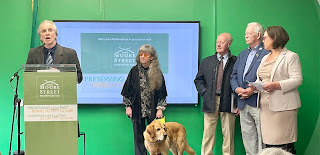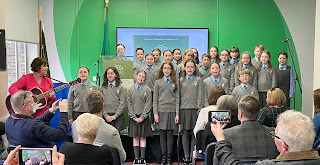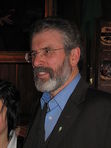A successful conference in support of Moore St: Mass graves an act of barbarism

A successful conference in support ofMoore St.
Last week The Moore StreetPreservation Trust and Uachtarán Shinn Féin Mary Lou McDonald organised aconference to support the development of a Historical 1916 Cultural Quarter inDublin City centre with Moore Street at its heart.
The conference was uniquely held inthe GPO in Dublin on 24 April, the date on which the Rising commenced in 1916.It was from that location at the end of Easter Week that several hundredVolunteers, led by five of the leaders, evacuated the burning GPO to MooreSt. This area is at the heart of our fight for freedom. 16 MooreStreet was the last HQ of the 1916 government of the Irish Republic.
It was in the buildings, streets andlaneways surrounding Moore Street that the Irish Republic was born and where itwas defended for six days by heroic patriots who believed in a better future.
The packed meeting of business andretail people, local traders and Save Moore St activists, as well as Relativesof the 1916 leaders heard contributions from a range of speakers including SeánAntóin Ó Muirí the architect who designed the alternative plan for the MooreSt. Preservation Trust. Seán’s presentation gave us a sense of what ispossible.
Uachtarán Shinn Féin Mary LouMcDonald who hosted the event in association with the Moore St. PreservationTrust, spoke of the ‘ambitious vision’ that the Relatives and the Trusthave for Moore St. She said: “The Master Plan presented by the MooreStreet Preservation Trust is a plan that weaves together much needed housing,retail, and cultural experiences throughout the historical quarter. It’s framedby the idea of the ‘economic of uniqueness’ whereby city centre cores arerevitalised through investment in the unique historical and culturalcharacteristics of a city to create compelling experiences.
This modern approach is driving theregeneration of city centres across the world - creating jobs, delivering newopportunities, fostering social progress and empowerment, and growing localeconomies and tourism sectors in a resilient and sustainable way. This iswhat Dublin needs, and it’s all possible, all achievable.”
The opening contribution was by LizGillis historian and James Connolly Heron, great grandson of James Connolly.The two spoke of the importance of Moore St and cited the campaign to saveKilmainham Jail. Over the centuries that prison held hundreds of republicanprisoners through a succession of rebellions. It was there in May 1916 that 14of the leaders, including the five who had been in Moore St, were executed byBritish firing squads. In the 1930s there were plans to demolish the buildingwhich remained empty and derelict until the establishment ofthe Kilmainham Gaol Restoration Committee in 1958. Hundreds of volunteerworkers persevered for years following 1960 to replace the roof and protect thebuildings. If it had been left to the government Kilmainham Prison would havedeteriorated beyond repair. Today it is the second most popular visitorattraction on the island of Ireland and is among the top ten museums in theworld.
For Liz Gillis and James ConnollyHeron the lesson of Kilmainham is especially pertinent to Moore St.
Professor Terry Stevens is aninternational tourism expert who works with the United Nations in destinationdevelopment. In his contribution he described Moore St as a “unique andremarkable” project that can “deliver something very special to the story ofIreland and to Dublin” and can “enhance the overall appeal of your capitalcity.”
It was a point made time and again inthe course of the conference by local and international contributors.
Paddy Cullivan is a musician,presenter, historian, comedian and all round entertainer whose successful oneman shows on historical characters like Michael Collins and Wolfe Tone are funny,insightful and reveal much about our history that others have sought to reviseand hide.
With the use of photographs hereminded us of the many iconic buildings – Carlow Jail, Kilkenny Workhouse,Frascati House - and other locations from our past that have been swept away bydevelopers and planners to be replaced mostly by shopping centres and hotels.He reminded us that the greed of some has destroyed important parts of ourimportant historical infrastructure.
Clearly the people of Dublin andIreland will be better served by Seán Antóin Ó Muirí’s proposal andplan for Moore Street than the developers proposal to demolish this battlefield site. If properly developed this unique initiative will generatejobs and income alongside a sense of pride and respect for the men and women of1916.
Michael Murphy is an architecturaldesigner, educator and writer. He designed the National Memorial for Peaceand Justice in Montgomery Alabama which includes the National LynchingMemorial. It is a striking monument which commemorates a dark time in UShistory but which has also significantly contributed to the economicregeneration of Montgomery. Michael flew in from Boston to support The Trust’splan.
Others who contributed to a verysuccessful day were Stephen Troy a fifth generation butcher on Moore St, HarryConnolly from Fáilte Feirste Thiar, Caroline Alwright a fourth generationmarket stall owner and Jean McCabe of Retail Excellence Ireland.
 All in all it was a hugelyinformative day. The choir from Gaelscoil Coláiste Mhuire sang a rousingversion of ‘Óró, sé dobheatha abhaile’ and Uachtarán Mary LouMcDonald called on the government to “withdraw its backing for theHammerson plan and instead throw its weight fully behind the vision for MooreStreet as set out by the Moore Street Preservation Trust. It should alsoprogress and action the Ceathrú Chultúir 1916 Bill drafted by Aengus Ó Snodaighand passed unanimously by the Dáil in 2021.”
All in all it was a hugelyinformative day. The choir from Gaelscoil Coláiste Mhuire sang a rousingversion of ‘Óró, sé dobheatha abhaile’ and Uachtarán Mary LouMcDonald called on the government to “withdraw its backing for theHammerson plan and instead throw its weight fully behind the vision for MooreStreet as set out by the Moore Street Preservation Trust. It should alsoprogress and action the Ceathrú Chultúir 1916 Bill drafted by Aengus Ó Snodaighand passed unanimously by the Dáil in 2021.”
Her comments were echoed by JamesConnolly Heron and the Relatives of the Signatories who attended the conferenceand by the Preservation Trust. In a statement at the end of the conference andin a letter to An Taoiseach Simon Harris, James Connolly Heron advocatedthe alternative plan, and asked for a meeting with Mr. Harris “to present thealternative plan to you in person at the earliest opportunity. We believethat a meeting with you to discuss this alternative vision for Dublin Centralwill be of benefit in progressing a plan that will have the support of allinterested parties.”
It’s now over to An Taoiseach.
Mass graves an act of barbarism
Atthe weekend Leas Uachtarán Michelle O’Neill was in London to address amassive pro-Palestinian march. She described what is happening in Gaza as the“gravest human rights violation of our time.” Michelle called for "an immediate, unconditional andcomplete ceasefire. We need to see an end to genocide, ethnic cleansing,and collective punishment. All hostages should be released immediately and allaid for Gaza must be delivered immediately, and Israeli forces must withdrawfrom Gaza and the West Bank.”
Her call follows on the devastating reports thatmass graves have been found at two hospitals, Nasser and al-Shifa inthe Gaza Strip containing the bodies of 400 women, children and the elderly, aswell as doctors and nurses. Many had their hands tied and some were buriedalive. They were all executed by the Israeli military.
The Falls
I love photographs. Especially old photos. Particularly blackand white ones. Bill Kirk is a veteran photographer. The Falls ishis most recent collection, some twenty years after Images ofBelfast. It captures a time and a neighbourhood which has gone. AsRobin Livingstone in the Foreword says, ‘It is avital and compelling historical archive, describing in rich detail the peopleand places where the latest conflict in the shared and troubled history ofIreland and Britain took place.’
Well done Bill Kirk and Frankie Quinn, Director of the Belfast ArchiveProject. I really enjoyed trawling through Bill’s images, spotting old friendsand associates as well as places where I spent my childhood.I wholeheartedly recommend THE FALLS.
THE FALLSis availible from An Fhuiseoig, Falls Road.
Gerry Adams's Blog
- Gerry Adams's profile
- 29 followers



